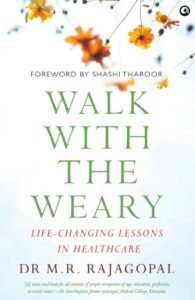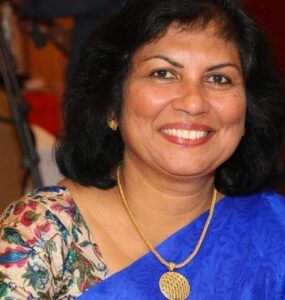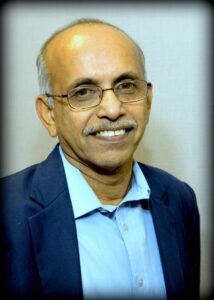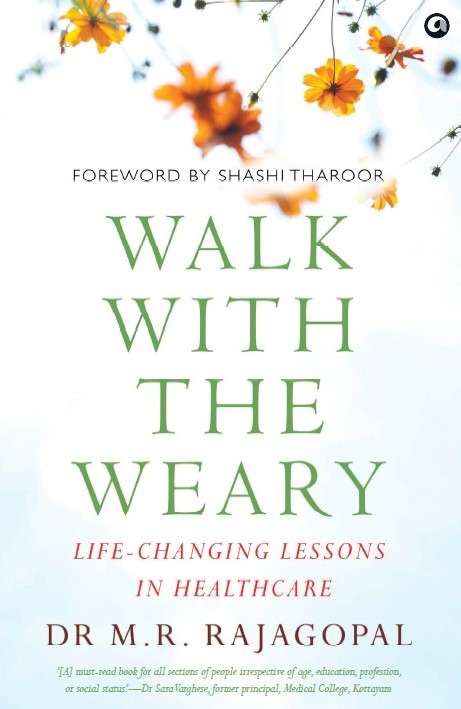WALK WITH THE WEARY


Let me start by saying this book is a challenging read. Brace yourself for some stark realities of life. The book chronicles human stories of physical and emotional pain and how many of the characters were helped to face their end-of-life challenges alongside a physician who understood and valued the lives of rich and poor alike.
Compassionate care is what you see throughout this book. Where does all of this begin in the author’s journey? It is not an overnight revelation. Being separated from parents and siblings at the tender age of three, living with grandparents, watching and being part of the lives and happenings of the family members, Pain, Grace, Resilience, and accepting death as inevitable, are all lessons learned early on. Mahatma Gandhi seems to have been the most significant influencer in the author’s life. To quote the author: I remember his words when I have to walk unknown paths: “Whenever you are in doubt or when the self becomes too much with you, apply the following test: Recall the face of the poorest and the weakest man/woman whom you may have seen, and ask yourself if the step you contemplate is going to be of any use to him. Will he gain anything from it? Will it restore him to control over his own life and destiny?”

While a commuting medical student at Trivandrum Medical College, the author describes the painful screams of a distant cousin suffering from a rare brain tumor. Easing a cancer patient’s pain was unheard of at that point in time. Being a medical student at the time, the author was helpless and walked away from the scene. The extreme sense of guilt haunted him for the rest of his life but also helped him engage in thoughts about pain relief for the suffering. The author later finds it gratifying to practice as an anesthesiologist and see patients’ smiling faces after surgeries.
Early in his career, the author sees the corruption and exploitation of people experiencing poverty in the healthcare industry and chooses to stick with a comfortable government job at Trivandrum Medical College.
In his treatment of the patient Morris, who suffered severe burns, he is concerned about the addictive nature of morphine and other opioids but advocates its use for pain relief in a very safe and responsible manner using “The Principle of Balance.”
The book weaves in and out of the stories of several young and old patients, but each story ends with lessons learned. Here are a few. A doctor must always be ready to listen to the patient. From Warrior, the elderly cancer patient, the author learns the value of listening.
Choosing to sometimes let go gently into the night instead of unnecessary medical treatment was the request of a father who knew his child had an incurable condition.
Calming the fears and anger of children like Joseph and Robin when facing the inevitable and providing hope for kids like Thasleena, who initially refused amputation of her leg are some other lessons learned.
Sitting down with families and letting them know you genuinely care is another important aspect palliative care. At this point, they allow you to enter their private and intimate space. Palliative care is not just about treating the patient but also learning to deal with loved ones.
The importance of talking to the patient instead of talking about the patient is of great value. The patients should not feel that they are being stripped of all rights. Families making decisions while the patient is being sidelined makes it more complicated. When struggling with illness, some patients are capable of taking control of their lives.
When a doctor is sincere in his/her profession and faithful to his calling, understands pain and suffering, and is filled with compassion for the suffering of humanity, ideas begin to emerge. The Pain and Palliative Care Society was birthed out of such a need.
The author acknowledges Suresh, Ashok, Dr. Molly John, Dr. Ramdas, Dr. Achuthan Nair, and Thikkodian as founders of the Palliative Care Society.
Gilly Burn is an unforgettable character in the author’s life. Her lecture, followed by her interest in the author’s palliative care work, allowed him to study abroad at Oxford.
Dr. Twycross validated international support. WHO accepts the palliative care in Kerala as a demonstration project. The retired businessman and philanthropist Bruce Davis extends financial assistance to the project. He went on to pay for the construction of Palliative Medicine in Calicut. Good people with generous hearts step in when you work for people in need and the less fortunate.
The author continues to emphasize the need for family support, community participation, and teamwork for any successful project. He recognizes his wife Chandrika, nurses Molly, and Lizzy and his friend Ashok have stood by him in his journey of Walking with the weary.
The author retires from government service at the age of 55 and begins working at a for-profit hospital in Cochin with the intent of charitable work. He realizes that palliative care is a need of the hour that should not be limited to Kerala. Palliative care was only available to 1% of Indians at this time. Pallium India was established to serve the larger population in India.
With a vision to integrate palliative care into the National level, the author leaves his private job and starts working with Central and State governments to influence policies that affect the access to education and development of palliative care centers and to make palliative care part of the healthcare system. In 2016, Kerala University incorporated palliative care into its curriculum. In many of these places, he sees the transformation of lives where pain and suffering faces of many are replaced by smiles of gratitude.
The author advises, “There is nothing more we can do,” from your physician should never be taken for granted. Patients should be given the hope of going away with minimal pain through proper pain management practices. It also eases the anxieties and fears of the families who want to be there to help.
He credits Paracelsus, a famous Swiss physician, alchemist, Theologian, and philosopher of the German Renaissance, for his quote, “The most fundamental principle is Love.” He hopes medical science will discover the pathway by which a loving hand on a fevered brow leads to the heart.
Some critiques may say that the author jumps from narration to reflection and then back to narration. I prefer to read the book and understand the lesson behind each narration and what the author has learned from his experiences. The reader then gets the true meaning of Compassion and Care.
Dignity and respect are what the writer hopes for in his last days of illness or death. He believes in the right to a compassionate and responsive medical system that will not reject the human being in him just because his disease is incurable.
There is much more to achieve in the world of Palliative Care, particularly in Kerala and India.
Let me conclude by quoting the author. When we dare to face the issue and accept that health is not only “absence of disease or infirmity” but also “physical, social and mental well-being,” we can focus on the quality of life and address relevant psychosocial issues such as loneliness, stigma, and abandonment, even while treating the illness.
